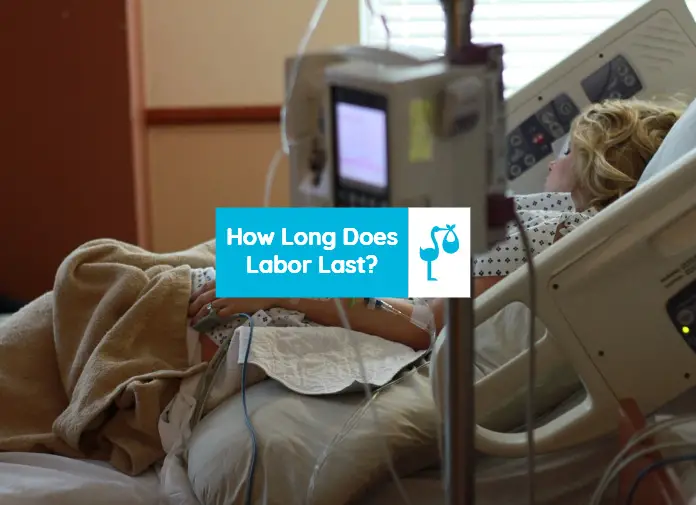How long does labor last? Active labor (when you feel rapid contractions) lasts for 7 hours. Early labor can last for 18 hours in the first pregnancy. The average length of labor is 6-12 hours. Second-time mothers have a shorter labor. Precipitous labor or rapid labor can last for only 2 hours.
If you’re pregnant for the first time, you must have wondered about how long does labor lasts? Average labor time is the duration for which most women experience labor. First-time moms have a longer average time in labor compared to the ones giving birth a second time.

How Long Does Labor Last?
A lot of you might be finding contradictory values of average labor mentioned by different people. Depending on many factors such as age, the average time of labor can vary.
Generally, your friends who have been pregnant will only tell you about active labor. That’s because they never count the early labor in average length. Early labor isn’t the shrieking and wreathing you expect. The average length of early labor is near 6-12 hours.
The average time of labor for the first baby is almost half of the average labor time for the second baby. Changes in the cervix and pelvic muscles affect the duration of active labor the second time.
Your cervix goes on dilating after you’re in early labor. For the effaced value beyond 10 cm, it takes an hour to push out the baby. The second time mothers can have the baby out within 15 minutes.
Precipitous labor is even faster and often leads to trauma.
What factors determine the average time of labor?
The average time for labor depends on many factors that the history of pregnancies. The dilation of the cervix and how fast the birth canal widens is a major factor controlling average labor time.
Women having premature labor before completing the full term of pregnancy have faster labor. Precipitous labor is rapid.
The strength of the contractions of vagina walls also affects average birth labor time. Epidurals are childbirth anesthetics that increase labor time.
The average labor time for the first baby when induced is lesser. When the mother is conscious and actively pushes and tries, labor can be quick.
Similarly sitting in upright positions favored by gravity quicken labor. The position of the bay and having hold of the situation favors easy and quick labor.
Factors affecting the duration of labor
- Age of mother
- Position of baby
- Size and makeup of pelvis
- Contractions strength
- Labor type – natural or induced
The movement of the baby also affects the duration of labor. If there is enough movement inside the womb, then the contractions become stronger. The movement of the baby sends the signal to the brain to trigger the release of labor hormone.
What are the three stages of labor?
One of the reasons why your friends or relatives tell you the different lengths of labor is that labor has three stages.
The first stage doesn’t involve rapid contractions and water may not break. Once the contractions are strong enough, it leads to active labor. Finally, the placenta comes out and completes the labor.
The prolapse of the umbilical cord is a complication in which other parts come out before the baby.
1) Early labor
The cervical canal gets the baby aligned for coming out. Thinning of the cervix from the birth canal region, called effaced cervix occurs. Some women have pregnant water leaking at this stage. Once the water breaks, blood and mucus come out. The mucus and blood comprise the bloody show. However, as the contractions are not strong enough, the baby would not come out. This stage of labor is only for the positioning of the baby and opening the birth canal.
The first stage of labor can be mild enough not to come to the notice of the mother. During the third trimester, women have Braxton Hicks that mimic labor. So a woman who has less frequent contractions may confuse the two. Midwives won’t consider you in labor until there is enough dilation.
2) Active labor
Average labor time for first-time moms includes 4-8 hours of active labor. During this stage, the contractions are more regular and rapid. Some records consider active labor as the average time of labor.
According to medical terms, the average time of labor after the bloody show and early labor both comprise the total length of labor. Women who have had previous vaginal deliveries tend to have short-length active labor. There can be passive labor when the cervix effaces but the urge to push is not enough.
Even after a woman reaches the second stage of labor, she may not be allowed to push. It is because if the cervix is not dilated enough, there can be tearing beyond normal. Third-degree tearing during labor takes a long to heal. Similarly, if you are lying entirely flat, then the contractions will not be able to lead to the transition stage.
The stage of labor where the latent phase changes into active labor is known as transition labor. When the cervix effaces beyond 10 cm, your doctor will ask you to push. The right time to push with all strength is after this stage.
Labor is an intensively energy-requiring process, and after every push, there is a sense of fatigue. Experts can judge when is the right time to start pushing during labor.
3) Placenta delivery
The third stage includes the removal of the placenta from the womb. Any part of the placenta remaining inside the womb can cause complications. During rapid labor, the placenta does not come out completely. This stage can take up to one hour or as little as 10 minutes.
How long is labor for first-time moms?
Your grandmothers may recall that they were in labor for three days or so. This is not the screaming labor that you see in movies. When a woman says that she had labored for two days, she includes the latent phase of labor.
Some women may never come to know the difference between latent labor and loosening of bowels. There is discomfort during this stage, but no contractions or pain occurs. Nobody can give you an exact prediction for when your labor will start.
Midwives look for dilation of the cervix. When the contractions are rapid and occur for 5-60 seconds every 4-5 minutes, then you are in active labor. At the start of labor, your cervix will dilate to 1.6 inches or 4 cm.
The active labor stage has 10 cm dilation and indicates that the mother is ready to give birth. The region below the waist loses sensation when a woman in labor takes an epidural.
Naturally, the muscles lack the synchrony and vigor for labor and the mother may not be able to push. Even after sufficient dilation, contractions are essential to push the baby out.
Average Duration Of Early Labor For First Time Moms
Active labor can be similar for mothers delivering consequent times. Early labor is where most women differ. Some are quick-settling babies who drop down and come out. Others are slow who gradually come midway and then rest before moving ahead.
Early labor has many processes going on like lightning, effacement, dilation, the release of mucus plug, and contractions getting strong. First-time mothers take up to 18 hours to come to active labor.
First-time mothers can expect to be in early labor for 6-10 hours. Certain Kegels, birth balls, hot tubes, and positions can reduce the length of early labor.
Impatience during labor can be a major setback to a natural delivery. Birthing classes focus on teaching breathing patterns that help you calm down during labor transitions.






![Why Do You Fast Before Cesarean? [Fasting Before C-Section Facts] Why do you fast before Caesarean?](https://www.pregnanteve.com/wp-content/uploads/2019/03/fast_before_cesarean-218x150.jpg)


